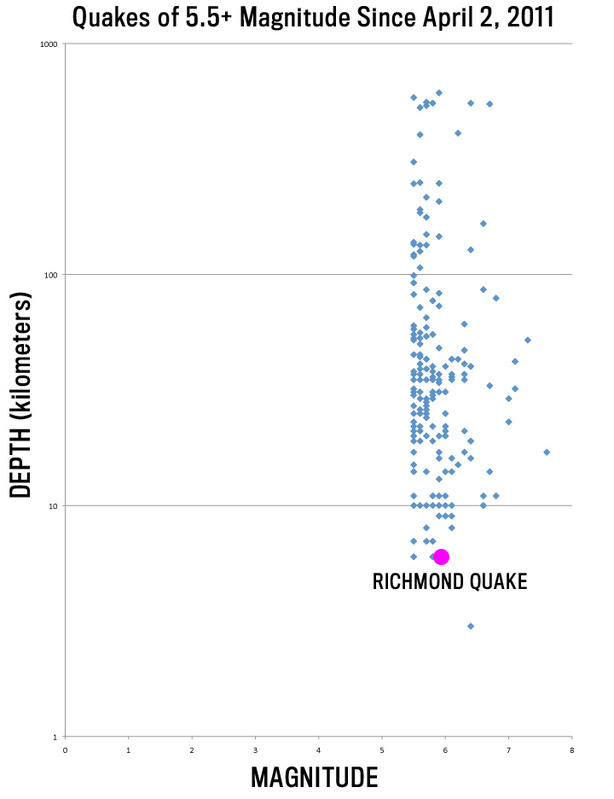How Did So Many People Feel a 5.8 Earthquake in Richmond, Virginia?
People from South Carolina to New York to Akron, Ohio, felt an earthquake that struck near Richmond, Virginia, this afternoon. It was a rare earthquake for the eastern seaboard and a rare kind of earthquake, in general.
The Virginia quake struck at a depth of just 6 kilometers. That's unusual as the plot above shows (note it's logarithmic scale on the vertical axis). Most strong quakes occur deeper in the Earth's crust. The depth of a quake has a direct relationship with how intense humans at the surface perceive its shaking to be, although that depends on a lot of other things, too. Still, relative to a deeper quake, this 5.8-magnitude tremor was felt more strongly than you'd expect.
But there's something else going on, too. At first, I had the West Coast-native thought that perhaps it wasn't actually that far from Richmond to New York and it was just the weird perception of East Coast distances that made it seem a long way. But then I mapped the distance between Richmond and New York. It turns out that it's a little further than San Francisco to Santa Barbara. It'd be one strange quake that hit SF but left buildings in the LA metro area seriously shaking.
That's backed up by more data, too. The USGS maintains a website called "Did You Feel It?" that crowdsources perceived earthquake intensity data. The Virginia quake has a very interesting graph. Its intensity stayed high over hundreds of kilometers. Compare those numbers with yesterday's Colorado quake.
I should note, though, that depth doesn't fully explain these numbers. The Colorado quake was even shallower than the Virginia one, which means that some other geological factors account for the long-distance effect. That's probably because East Coast crust is "older and colder," which makes it a more efficient transmitter of seismic energy.
Of course, these are still just guesses. Every earthquake is different in precisely how it manifests. Earthquake intensities are determined by the acceleration of the earth in all three dimensions. In fact, if you record the x, y, and z motion, you can "play back" historical earthquakes on shake tables at places like the Pacific Earthquake Engineering Research Center.
We'll keep you updated on what geologists think happened.
Update 6:11pm: Check out this great post from Virginia geologist Callan Bentley for more about the interesting dynamics that produced this quake. (Via @burritojustice)
Update 7:18 AM: Watch seismic shocks ripple across the country. Credit: IRIS.

